The Rare Plants in The Alas Kedaton Tourism Forest, Tabanan, Bali
on
Advances in Tropical Biodiversity and Environmental Sciences 5(1): 1-11, February 2021 e-ISSN:2622-0628
DOI: 10.24843/ATBES.2021.v05.i01.p01 Available online at: https://ojs.unud.ac.id/index.php/ATBES/article/view/67099
1
Rare Plants in The Alas Kedaton Tourism Forest, Tabanan, Bali
Nyoman Wijana1, I Made Oka Riawan2*, and Sanusi Mulyadiharja3
123Biology Department, Faculty of Mathematics and Natural Sciences, Ganesha University of Education
* Corresponding author: made.oka@undiksha.ac.id
Abstract. Forests are a source of foreign exchange that has been exploited on a large scale for timber. This exploitation causes a rapid reduction in forest area. Until now, the destruction of the forest environment is still happening, both by illegal logging and illegal mining. This study aims to determine the number of rare plant species in Alas Kedaton Tourism Forest, Tabanan, Bali, Indonesia; and the factors causing the rarity of these plant species. The population in this research is the plant species in Alas Kedaton Tourism Forest. Meanwhile, the social population is all people in the Alas Kedaton Tourism Forest area. The sampling method for plant species is the quadratic method was used to investigate the diversity and the number of rare plants. While for the social sampling was conducted by interviewing with purposive sampling method to the local community around the Alas Kedaton areas. Determination of endangered plant species was conducted by studying of available documents, indepth interviewing, and seeking information from various existent sources. The collected data analyzed descriptively. The results of this study indicated there are 48 species of plants with 26 families, which are generally found in Alas Kedaton Tourism Forest. Of this number, 42 (87.5%) plant species are included in the rare category; (2) of the 42 species of rare plants in the Alas Kedaton Tourism Forest, there are 8 (19.04%) plant species that are included in the National rare category, 20 (47.62%) rare plant species in Bali, 10 ( 23.81%) rare plant species in Tabanan Regency, and 4 (9.52%) species included in the rare category at the District level (especially Marga District); and (3) factors causing the scarcity of plant species in Alas Kedaton Tourism Forest are (a) past environmental degradation, (b) reproductive problems of rare plants, (c) human intervention, (4) disturbance by animals, especially long tailed monkeys (Macaca fascicularis) and bats (Pteropus vampyrus).
Keywords: alas kedaton; rare plant species; tourism forest
management of protected forests and National Parks. These studies were conducted in various areas such as Arrijani in Cianjur, Irwanto in Maluku, Junaedi in West Java, Sri Hartini in East Kalimantan, Sunarti, et al in North Sulawesi, Onrizal in West Kalimantan, and Purwaningsih in Southeast Sulawesi. The context of this research is more oriented to the study of vegetation parameters or vegetation analysis.
One of the forest areas that is used as a tourist spot in Bali is the Alas Kedaton Forest, Kukuh Village, Marga District, Tabanan Regency, Bali, Indonesia. According [26] the area of the Alas Kedaton tourism object is approximately 12 ha, while the area of protected forest is approximately 6.5 ha. In this forest area there are large and dense trees, and there are several types of plants in the forest vegetation, which are included in the category of rare plants. From the description above, the problems examined in this study are (1) How big is the number of rare plant species in Alas Kedaton Tourism Forest, Tabanan, Bali, Indonesia? and (2) What factors cause the rarity of this plant species?
-
II. RESEARCH METHODS
This study was an exploratory research type, namely exploring the species diversity of rare plants in Alas
Kedaton Tourism Forest Area, located at Tabanan regency, Bali, Indonesia, with an area of 6.5 ha. The population in this study were plant species in Alas Kedaton Tourism Forest. While for social study was conducted by interviewing with purposive sampling method to the local community around the Alas Kedaton area. The sampling method for plant species is by using the quadratic method [9,27,28,29], while for the community sampling method is purposive sampling method. Samples of plant species are all plant species covered by a square measuring 20x20m of 100 squares. For the social sample, 25 people were taken and besides that, an interview was also conducted with the local government. The sampling technique for plant species was systematic sampling. The squares are placed continuously at intervals of 10x20m along the line compass, totaling 100 squares. Each square is recorded on the plant species that comprise it. The plant species that have been collected are then determined by plant species that are included in the rare category. Determination of this rare plant species is done by studying existing documents, conducting interviews, and seeking information from various available sources. Furthermore, with in-depth interviews with informant sources from communities around the forest area, and including the District and Provincial Forestry Services, information is obtained regarding rare plants which are included in the category of rare national, rare at the provincial level of Bali, rare at the level of Tabanan Regency, and rare at the Marga and Kukuh Village levels. The data were further analyzed descriptively [30]
The recapitulation of research results on plant species in Alas Kedaton Tourism Forest is presented in detail in the plant floristic list in Table I. There are 48 plant species found in Alas Kedaton Tourism Forest, which are included in 26 families, with the following family details: Meliaceae (8 species), Moraceae (7 species), Lauraceae (3 species), Annonaceae (3 species), Myrtaceae (2 species), Myristicaceae (2 species), Arecaceae (2 species), Anacardiaceae (2 species), Apocynaceae (2 species), Sterculiaceae (1 species), Lythraceae (1 species), Euphorbiaceae (1 species), Clusiaceae ( 1 species), Sapotaceae (1 species), Lecythidaceae (1 species), Combretaceae (1 species), Phyllanthaceae (1 species), Rubiaceae (1 species), Caesalpinioceae (1spesies), Sabiaceae (1 species), Elaeocarpaceae (1 species) , Verbenaceae (1 species), Malpighiaceae (1 species), Cornaceae (1 species), Rubiaceae (1 species), and Leeaceae (1 species).
From the flora floristic list above, then by using literature / document studies, interviews, and some relevant information, it is possible to obtain rare plant species as presented in Table II.
Based on Table 2, there are 48 plants species that are generally found in the Alas Kedaton Tourism Forest, it appears that there are as many as 42 (87.5%) plants species that are included in the rare category. This rare plant category is based on document / literature studies with reference to the Forest Service which has determined several rare plant species. In addition, it is also based on interviews with informant sources around the Alas Kedaton Tourism Forest. This was also accompanied by interviews with people who generally live outside the Alas Kedaton Tourism Forest, even to people outside Tabanan Regency. From the results of literature studies and interviews with the community and the Provincial and District Forestry Services, it was found that rare plant categories such as national rare plants, rare at the Bali Province level, rare at the Tabanan Regency level, and rare at the Marga and Kukuh Village District levels.
From Table 2 it can be seen that there are 8 (19.04%) plants species that are included in the National rare category, 20 (47.62%) rare plants species at the Bali Province level, 10 (23.81%) rare plant species at the level of Tabanan District, and 4 (9.52%) species are in the rare category at the Marga Sub-district level, including rare at the Kukuh Village level.
When viewed from the number of individual species present, from an area of 20x20m squared as many as 100 squared, the rare plant species with the highest number of individuals are from the Taluh Wood (Vitex glabrata) plant species, with the number of individuals as much as 1,275 individuals, while the least number of individual species are Green Banyan (Ficus benyamina), Pulai/Pule (Alstonia scholaris), Badung (Garcinia divica), Mini Cashew (Semecarpus cassuvium, and Genitri (Elaeocarpus ganitrus), each with 1 individual species.
Thus it can be stated that in the Alas Kedaton Tourism Forest, as a place of conservation of rare plants, there are quite a lot of rare plant species in the forest. It also appears that the number of individuals belonging to the rare plant category was only found to be only one individual species in an area of 20x20mx100m with intervals between squares of 10x20m. So it is very worrying for plant species with such conditions. This needs special attention for local forest tourism managers. Below are given some examples of rare plant species in Alas Kedaton Tourism Forest, Tabanan, Bali, Indonesia. See Table III.
TABLE I
GENERAL FLORISTIC LIST OF PLANT SPECIES IN ALAS KEDATON TOURISM FOREST, TABANAN, BALI, INDONESIA
|
No. |
Familiy |
Name of Plant Species |
*) Local Name Using | |
|
Local Name*)/ Indonesia |
Scientific Name | |||
|
1 |
Anacardiaceae |
Dau Mete Mini |
Dracontomelum mangiferum Semecarpus cassuvium |
Balinese |
|
2 |
Annonaceae |
Sandat Blakatak Kayu Madas |
Cananga adorata Polyalthia lateriflora Polyalthia korinti | |
|
3 |
Apocynaceae |
Pulai/ Pule Bukak |
Alstonia scholaris Rauwolfia javanica | |
|
4 |
Arecaceae |
Rotan Jaka/ Aren |
Calamus axillaris Arenga pinnata | |
|
5 |
Caesalpinioceae |
Benul |
Parkia speciosa | |
|
6 |
Clusiaceae |
Badung |
Garcinia divica | |
|
7 |
Combretaceae |
Kayu Kunyit |
Terminalia sumatrana | |
|
8 |
Cornaceae |
Jelit-Jelit |
Alangium salviifolium | |
|
9 |
Elaeocarpaceae |
Genitri |
Elaeocarpus ganitrus | |
|
10 |
Euphorbiaceae |
Buni Hutan |
Antidesma bunius | |
|
11 |
Lauraceae |
Bejulitan Kayu Besi Kayu Manis |
Litsea glutinosa Eusideroxylon zwageri Cinnamomum burmani | |
|
12 |
Lecythidaceae |
Putat/ Kutat |
Planchonia valida | |
|
13 |
Leeaceae |
Gegirang |
Leea sp. | |
|
14 |
Lythraceae |
Tangi/Bungur |
Lagerstroemia speciosa | |
|
15 |
Malpighiaceae |
Bergiding |
Hiptage benghalensis | |
|
16 |
Meliaceae |
Majegau Kayu Adeng Kepohpoh Kayu Bawang Kayu Nyoling Sentul Mahoni Langsat Lutung |
Dysoxylum densiflorum Dysoxylum caulostachyum Buchanania arborescens Dysoxylum alliaceum Pisnoid umbellata Sandoricum koetjape Swietenia mahagoni Aglaia argentea | |
|
17 |
Moraceae |
Beringin Hijau Teep/ Terep Ae/ Ara Bunut Serut/ Pungut Kacu-Kacu Awar-Awar |
Ficus benyamina Artocarpus elastica Ficus racemosa Ficus altissima Streblus asper Ficus magnoliaefolia Ficus septica | |
|
18 |
Myrisinaceae |
Lampeni |
Ardisia humilis | |
|
19 |
Myristicaceae |
Kayu Anak |
Knema laurina | |
|
20 |
Myrtaceae |
Kaliampuak/ Jambu Hutan Salam |
Eugenia densiflora Syzygium polyanthum | |
|
21 |
Phyllanthaceae |
Gintungan |
Bischofia javanica | |
|
22 |
Rubiaceae |
Kayu Nyan-Nyan Jarum-Jarum |
Guettarda speciosa Pavetta subvelutina | |
|
23 |
Sabiaceae |
Kayu Sambuk |
Meliosma pinnata | |
|
24 |
Sapotaceae |
Nyantuh |
Palaquium javanicum | |
|
25 |
Sterculiaceae |
Bayur |
Pterospermum javanicum | |
|
26 |
Verbenaceae |
Kayu Taluh |
Vitex glabrata | |
TABLE II
LIST OF RARE PLANT SPECIES IN ALAS KEDATON TOURISM FOREST, TABANAN, BALI, INDONESIA
|
No. |
Familiy |
Name of Plant Species |
Number of Individuals |
Status | |
|
Local Name*)/ Indonesia |
Scientific Name | ||||
|
1 |
Anacardiaceae |
Dau |
Dracontomelum |
8 |
LB |
|
mangiferum | |||||
|
Mete Mini |
Semecarpus cassuvium |
1 |
LB | ||
|
2 |
Annonaceae |
Sandat |
Cananga adorata |
2 |
LN |
|
Blakatak |
Polyalthia lateriflora |
7 |
L.Kab | ||
|
Kayu Madas |
Polyalthia korinti |
17 |
L.Kec | ||
|
3 |
Apocynaceae |
Pulai/ Pule |
Alstonia scholaris |
1 |
LN |
|
Bukak |
Rauwolfia javanica |
78 |
L.Kab | ||
|
4 |
Arecaceae |
Rotan |
Calamus axillaris |
6 |
LB |
|
Jaka/ Aren |
Arenga pinnata |
2 |
LB | ||
|
5 |
Caesalpinioidea |
Benul |
Parkia speciosa |
4 |
LB |
|
6 |
Clusiaceae |
Badung |
Garcinia divica |
1 |
LN |
|
7 |
Combretaceae |
Kayu Kunyit |
Terminalia sumatrana |
9 |
LB |
|
8 |
Elaeocarpaceae |
Genitri |
Elaeocarpus ganitrus |
1 |
LB |
|
9 |
Euphorbiaceae |
Buni Hutan |
Antidesma bunius |
2 |
LN |
|
10 |
Lauraceae |
Bejulitan |
Litsea glutinosa |
26 |
LB |
|
Kayu Besi |
Eusideroxylon zwageri |
7 |
LB | ||
|
Kayu Manis |
Cinnamomum burmani |
57 |
L.Kab | ||
|
11 |
Lecythidaceae |
Putat/ Kutat |
Planchonia valida |
12 |
LB |
|
12 |
Lythraceae |
Tangi/Bungur |
Lagerstroemia speciosa |
9 |
LN |
|
13 |
Malpighiales |
Bergiding |
Hiptage benghalensis |
79 |
L.Kab |
|
14 |
Meliaceae |
Majegau |
Dysoxylum densiflorum |
5 |
LN |
|
Kayu Adeng |
Dysoxylum caulostachyum |
23 |
LB | ||
|
Kepohpoh |
10 |
LB | |||
|
Kayu Bawang |
Dysoxylum alliaceum |
60 |
L.Kab | ||
|
Kayu Nyoling |
Pisnoid umbellata |
4 |
L.Kab | ||
|
Sentul |
Sandoricum koetjape |
3 |
L.Kab | ||
|
Mahoni |
Swietenia mahagoni |
63 |
L.Kec | ||
|
Langsat Lutung |
Aglaia argentea |
13 |
L.Kec | ||
|
15 |
Moraceae |
Beringin Hijau |
Ficus benyamina |
1 |
LN |
|
Teep/ Terep |
Artocarpus elastica |
32 |
LB | ||
|
Ae/ Ara |
Ficus racemosa |
18 |
LB | ||
|
Bunut |
Ficus altissima |
2 |
LB | ||
|
Serut/ Pungut |
Streblus asper |
2 |
L.Kab | ||
|
Kacu-Kacu |
Ficus magnoliaefolia |
5 |
L.Kec | ||
|
16 |
Myristicaceae |
Kayu Anak |
Knema laurina |
5 |
LB |
|
17 |
Myrtaceae |
Kaliampuak/ Jambu |
Eugenia densiflora |
11 |
L.Kab |
|
Hutan | |||||
|
18 |
Phyllanthaceae |
Gintungan |
Bischofia javanica |
5 |
LB |
|
19 |
Rubiaceae |
Kayu Nyan-Nyan |
Guettarda speciosa |
4 |
LB |
|
20 |
Sabiaceae |
Kayu Sambuk |
Meliosma pinnata |
3 |
LB |
|
21 |
Sapotaceae |
Nyantuh |
Palaquium javanicum |
34 |
LB |
|
22 |
Sterculiaceae |
Bayur |
Pterospermum javanicum |
11 |
LN |
|
23 |
Verbenaceae |
Kayu Taluh |
Vitex glabrata |
1275 |
L.Kab |
Information:
LN: National Rare protected by law (PPRI No. 7 of 1999)
LB: Rare in Bali protected by law (PPRI No. 7 of 1999)
L.Kab: Rare in Tabanan Regency
L.Kec: Rare in Marga District
*): Local Name Using Balinese
TABEL III
IMAGE/FIGURE AND DESCRIPTION OF PLANT SPECIES IN ALAS KEDATON TOURISM FOREST
-
1. Kayu Taluh (Vitex glabrata)
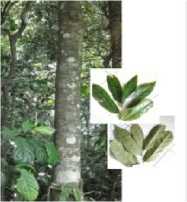
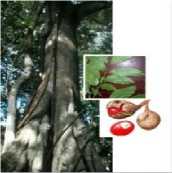
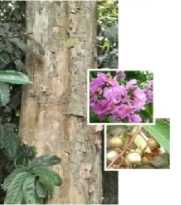
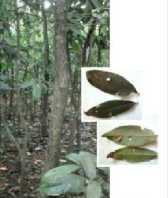
Kingdom : Plantae
Divisio
: Magnoliophyta
Class
: Magnoliopsida
Order
: Lamiales
Family
: Verbenaceae
Genus
: Vitex
Species
: Vitex glabrata
This plant is a tree, reaching ± 25 m in height, 35 - 45 cm in diameter. This tree has many branches that are not straight / bent and irregular. The wood is quite hard, dense, straight grain, greenish to yellow brown. The leaves are pinnate with egg-shaped leaves until they are oval / elliptical and taper to the tip and base of the leaf
Kingdom : Plantae
Divisio : Magnoliophyta
Class : Magnoliopsida
Order : Sapindales
Family : Meliaceae
Genus : Dysoxylum
Species : Dysoxylum alliaceum
Plants with a height of up to 20-25 m with a stem diameter of 40-60 cm. The trunk is straight with white wood without a terrace. The leaves are pinnate with sitting leaves facing the lanceolate shape.
-
3. Tangi/ Bungur (Lagerstroemia speciosa)
Kingdom : Plantae
Divisio
: Magnoliophyta
Class
: Magnoliopsida
Order
: Myrtales
Family
: Lythraceae
Genus
: Lagerstroemia
Species
: Lagerstroemia speciosa
Plants with a height of 10-30 m. Round stems, branching from the base, light brown. Single leaf, stiff, short-stemmed. Leaf blade is oval, elliptical, 9-28 cm long and dark green. Compound interest, arranged in panicles. The fruit is box fruit, spherical to elongated, 2-3.5 cm long, has 3-7 space, the young fruit is green, after ripe it turns brown.
Kingdom : Plantae
Divisio : Magnoliophyta
Class : Magnoliopsida
Order : Ranales
Family : Lauraceae
Genus : Eusideroxylon
Species : Eusideroxylon zwageri
Plants up to 10 m tall. The stem is strong but the shape of the stem is bent. The leaves are pinnate, the tips of the leaves are pointed, the base of the leaves is
rounded, the edges of the leaves are flat. Branches are reddish brown. The fruit of this plant is a stone fruit, elliptical in shape, one seed 7-16 cm long and 5-9 cm wide.
-
5. Kayu Jelema/ Kayu Anak (Knema laurina)
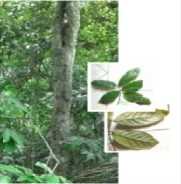
Kingdom : Plantae
Divisio
: Magnoliophyta
Class
: Magnoliopsida
Order
: Magnoliales
Family
: Myristicaceae
Genus
: Knema
Species
: Knema laurina
Plants with a height of ± 20 m. Batngnya light brown with red sap. Has an arillus that covers the whole seed pink. The leaf blade is pinnate in a lanceolate shape, with a smooth leaf surface.
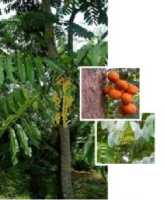
Kingdom : Plantae
Divisio : Magnoliophyta
ClasS : Magnoliopsida
Order : Sapindales
Family : Meliaceae
Genus : Dysoxylum
Species : Dysoxylum densiflorum
Plants up to 40 m tall with a diameter of 1.2 m. The trunk is woody, the wood is heavy, hard but finely fibrous with a light yellow to pinkish brown or brown-pink color, shiny. Majegau leaves are oval lanceolate. The fruit is ovoid with a length of between 3-6 cm, brown to orange.
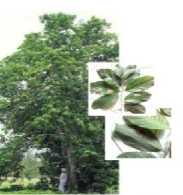
Kingdom : Plantae
Divisi : Magnoliophyta
Class : Magnoliopsida
Order : Malpighiales
Family : Phyllanthaceae
Genus : Bischofia
Species : Bischofia javanica
Plants with a height of ± 40 m, stem diameter 95 - 150 cm. The stems are straight, with no wood points or root bomi, not grooved. The shape of the egg round leaves are divided / curved into three and tapered to the ends of the leaves. Sitting leaves or spiral / circular, have long leaf stalks. inflorescences malai-shaped, small, found at the end of the stem with long flower stalks. The fruit is also small (1.2 -1.5 cm).
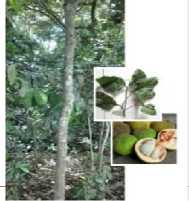
Kingdom : Plantae
Divisio
: Magnoliophyta
Class
: Magnoliopsida
Order
: Sapindales
Family
: Meliaceae
Genus
: Sandoricum
Species
: Sandoricum koetjape
A plant 30 m high, 90 cm in diameter, gummy like milk. Compound leaves alternating, pinnate with three leaflets, rounded or slightly tapered at the base, tapered at the tip; gleaming green above, dull green below. Flowers in panicles in axillary, hairy, hanging, up to 25 cm. The fruit of the buni is round slightly flattened, 5-6 cm, yellow or reddish when ripe, has a velvety fur.
-
8. Bunut (Ficus altissima)

Kingdom : Plantae
Divisio
: Magnoliophyta
Class
: Magnoliopsida
Order
: Urticales
Family
: Moraceae
Genus
: Ficus
Species
: Ficus altissima
Plants with a height of 20-30 m. The trunk is woody, cylindrical, dark brown color, smooth surface, the branching spreads irregularly to form a shady tree, the roots hanging from the trunk or branches that are already large. Single leaf, stemmed, arranged alternately (alternate), oval shape (elliptica), tapered tip and base (acuminatus), flat edges, shiny surface (nitidus), and has a smooth leaf surface.
Divisio : Magnoliophyta
Class : Magnoliopsida Order : Gentianales
Family : Apocynaceae
Genus : Alstonia
Species : Alstonia scholaris
Plants with a height of 10-50 m. The stems are erect, straight dark green. The leaves are single, lanceolate, the ends round and the base tapered, the edges flat. White and sticky rubbery, the bones of the leaves close, the central leaves circling 4-8 pieces. The flowers are compound, malai-shaped, with egg-shaped flower petals. The fruit is ribbon-shaped with a length of 20-50 mm and white.
Divisio : Magnoliophyta
Kelas : Magnoliopsida
Ordo : Malvales
Famili : Elaeocarpaceae
Genus : Elaeocarpus
Spesies : Elaeocarpus ganitrus
Plants with a height of 20-30 m. The trunk is upright, woody, round, and has brown leathery skin. Single leaf, green, oval-shaped with jagged edges, and tapered tip and base, measuring 8-20 cm long and 3-6 cm wide. Interest is a compound flower in the form of panicles. Jenitri fruit is buni type, round, green in color. The seeds are round, light brown to dark brown with a diameter of 0.5 cm -2 cm. The surface of the seed is hollow and grooved (threaded) as if it were carved.
-
11. Badung/ Mundu (Garcinia divica)
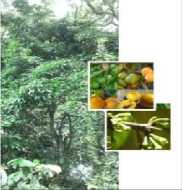
Kingdom : Plantae
Divisi
: Magnoliophyta
Class
: Magnoliopsida
Order
: Malpighiales
Family
: Clusiaceae
Genus
: Garcinia
Species
: Garcinia divica
Plants with a height of 13-15 m. The stems have brown skin and white rubber. The leaves are oval to oval in shape with a length of 10-30 cm. The flowers are whitish yellow. The fruit is light green to yellowish to 2.5 cm brown.
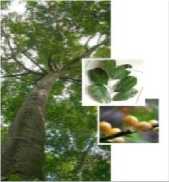
12. Nyantuh (Palaquium javanicum)
Kingdom : Plantae
|
Divisio |
: Magnoliophyta |
|
Class |
: Magnoliopsida |
|
Order |
: Ericales |
|
Family |
: Sapotaceae |
|
Genus |
: Palaquium |
|
Species |
: Palaquium javanicum |
Trees up to 30 meters high and 0.5 meters in diameter. Upright trunk with brownish red color. Pepagannya yellow to red and gummy white. Single leaf with round shape of breech eggs to elliptical. Flowers petals on the axillary leaves.
13. Teep/ Terep (Artocarpus elastica)
Kingdom : Plantae
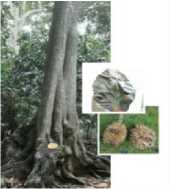
Divisio : Magnoliophyta
Class : Magnoliopsida
Order : Urticales
Family : Moraceae
Genus : Artocarpus
Species : Artocarpus elastica
A plant with a height of 25 m with a stem diameter of up to 80 cm. The leaves are large with a length of up to ± 50 cm, single, pinnate, the upper and lower leaf surfaces are hairy so they have a rough texture. The fruit is compound and protected by soft prickly skin.
-
14. Putat/ Kutat (Planchonia valida)
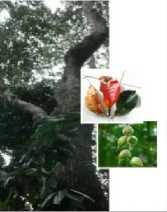
Kingdom : Plantae
Divisio : Magnoliophyta
Class : Magnoliopsida
Order : Lecythidales
Family : Lecythidaceae
Genus : Planchonia
Species : Planchonia valida
Plants up to 50 m tall, 200 cm in diameter, with upright, straight, and watery stems. The title is round, dense, dark green and shiny, which in the dry season the leaves fall off and before the red leaves fall off. The bark of the stem is grayish brown to dark brown, peeling in the form of small pieces. Bunchshaped inflorescences. The flowers have many stamens. The fruit is eggshaped or oval.
-
IV. DISCUSSION
From Table II it is clear that there are 42 (87.5%) rare plant species from a total of 48 plant species in the Alas Kedaton Tourism Forest. Meanwhile, according to the Bali Provincial Forestry Service (1987), of around 200 rare plants in Indonesia which were included in the IUCN (International Union for Conservation of Nature) category in 1978, 32 of them were already known in Bali. The amount of vegetation / flora in the Alas Kedaton Tourism Forest was carried out in 2003 and 2005, at this time the plant species experienced increasing changes. In 2003 and 2005, 29 rare plant species were identified from 43 plant species obtained, while at this time 42 species were identified from the 46 plant species obtained.
These changes are influenced by various factors from the environment and the activities of living things in it. [31] explains that the plant world community has dynamics or changes, both caused by natural and human activitie [32]. [16,17,18,19] Explains that changes in the natural environment or plant composition in an area can be caused by adaptation to soil environmental conditions, topography, geology and climate, through changes in the body and its functions, while the environment also undergoes changes through physical or biogeochemical processes to maintain quality. life support and community system balance.
This statement is in accordance with the results of an interview with the manager of the Alas Kedaton Tourism Forest, who explained that changes in the composition of plants that change the number of rare plants that exist today are due to efforts to revegtation in the tourism forest by spreading new plant seeds. On the other hand, there are rare plants in the forest area, old and dead, and not accompanied by replanting. In addition, according to the forest manager, some plants also died due to the influence of animal disturbances in this forest area, especially the Pteropus vampyrus animal group that occupies the Pterospermum javanicum plant as their habitat, thus disrupting the growth of these trees.
There are several opinions that state a plant species can become rare. The factors that cause plants to become rare can be grouped as follows.
-
1. Naturally rare as a result of both abiotic (fire, drought) and biotic (pests or disease) factors. This natural scarcity process is especially easy to occur in endemic plant species whose populations are grouped in certain areas such as the Rafflesia arnoldi plant in West Sumatra or plants that are not endemic but their population is relatively small and the distribution of the population is very far apart such as Sawo Kecik (Manilkara kauki) in Blambangan, Java. Timur, Prapat Agung Bali Barat, and Pedan in Sumbawa. Theoretically, the loss or rarity of a species will affect the survival of other species that are co-evolutionary [33].
-
2. The occurrence of rare plants as a result of human actions, directly or indirectly. Directly, this can be in the form of excessive exploration of a particular plant without adequate rehabilitation efforts, for example Eben wood (Diospyros celebica) in Sulawesi. Indirectly, for example, the destruction of forests due to air pollution or acid rain in developed industrial countries such as the Picea abiex plant in West Germany, where the damage was around 9% in 1982 increasing rapidly to 51% in 1984 [34]
From the results of in-depth interviews in the field, the factors causing the scarcity of rare plant species in Alas Kedaton Tourism Forest are:
-
1. Environmental degradation factors. In this context, it means that the existing forest, inherited by the current village youth generation, is the remnant of ancient forest, which now only reaches 27 Ha. Whereas in the past, the area was wider than it is today. In the past era of their parents, many converted forests into agricultural areas. The forest area that exists today, is left uncut because inside there is a temple as a holy place for Hindus to pray. So that the remaining forests that exist today are still believed to be sacred places for Hindus in Bali;
-
2. Plants which are categorized as rare, seen from the way of reproduction, take place very slowly, so that the parents are very unattractive to breed them; Thus, reproduction takes place only naturally, and its survival also takes place naturally;
-
3. Plants that are classified as rare plants have high quality wood, so that many plants that live outside this tourism forest are cut down and used for building materials;
-
4. Plants that are included in the rare category, which are considered "sacred wood" by the community, are often used more for sacred buildings (places of prayer for Hindus in Bali) or for religious ceremonies (Hinduism), not accompanied by breeding or nurseries as materials. substitute for plants that have been felled;
-
5. There has been no effort to carry out a nursery for rare plants by forest managers or by the surrounding community. This effort was not carried out due to the increasing difficulty of finding rare plants in their environment. Even though the economic value is quite high, because it is very rarely found in nature, people have switched to other wood, which is more practical, attractive and of quality to be used as building material or as a greening material;
-
6. In the Alas Kedaton Tourism forest, many rare plants also died, due to disturbance from animals, especially longtailed monkeys (Macaca fascicularis) and bats (Pteropus vampyrus). The population continues to increase. Plants are often used as a place to "play" and many of these plants are "disturbed". Plants whose fruit can be eaten ecologically are used as food by several populations of monkeys and bats in
the forest. The seeds that grow are often eaten or disturbed or broken so that the plant seeds die.
-
V. CONCLUSION
There are 48 species of plants that are generally found in Alas Kedaton Tourism Forest. Of these, 42 (87.5%) plant species are included in the rare category. Of the 42 species of rare plants in the Alas Kedaton Tourism Forest, 8 (19.04%) plant species are included in the National rare category, 20 (47.62%) rare plant species in Bali, 10 (23, 81%) endangered plant species in Tabanan Regency, and 4 (9.52%) species included in the rare category at the District level (especially Marga District). Factors causing the scarcity of plant species in Alas Kedaton Tourism Forest are (1) ancient environmental degradation, (2) reproductive problems of rare plants, (3) human intervention, (4) disturbance by animals, especially long-tailed monkeys (Macaca fascicularis) and bats (Pteropus vampyrus).
REFERENCES
-
[1] Wijana, N., IN Sumardika. 2004. Penentuan Kualitas Air Danau Batur (Kajian dari Sisi ABC Envirotment). Research Institutin (not published).
-
[2] Wijana, N., IN Sumardika. 2005. Analsis Vegetasi Hutan Bukit Kangin Desa Adat Tenganan Pengringsingan, Kabupaten Karangasem. Research Institutin (not published).
-
[3] Wijana, N., M Sutajaya, N Kariasa. 2006. Analisis Kualitas Air, Aspek Kesehatan Masyarakat, Vegetasi Penyangga dan Upaya Pengelolaan oleh Masyarakat Seputar Danau Batur Kecamatan Kintamani Kabupaten Bangli. Research Institutin (not published).
-
[4] Wijana, N. 2009. Pelestarian Jenis-Jenis Tumbuhan Berguna Melalui Kearifan Lokal di Desa Adat Tenganan Pegringsingan, Kabupaten Karangasem, Bali. Dimuat dalam prosiding Konservasi Flora Indonesia dalam Mengatasi Dampak Pemanasan Global. Kebun Raya “Eka Karya – LIPI. Hal. 724 -731. ISBN 978-979-799-447-1.
-
[5] Wijana, N., IBJ Swasta, IN Sumardika. 2010. Analisis ABC Environment pada Ekosistem Tumpang Tindih (Overlap Ecosystem) dalam Kaitannya dengan Penurunan Kualitas Air, Eutrofikasi, dan Rencana Pemantauan Lingkungan (RPL) Danau Buyan Kecamatan Sukasada Kabupaten Buleleng. Research Institutin (not published).
-
[6] Wijana, N. 2012. Analisis Dampak Lingkungan Dan Upaya Pengelolaan Berbasis Ergologi Kawasan Wisata Lovina, Buleleng – Bali. Research Institutin (not published).
-
[7] Wijana, N. 2013a. Analisis Vegetasi Hutan Adat, Upaya Pengelolaan Berbasis Kearifan Lokal dan
Pemberdayaan Masyarakat Melalui Pendekatan Ergologi di Desa Bali Aga Buleleng-Bali. Research Institutin (not published).
-
[8] Wijana, N. 2013b. Analisis Komposisi dan Keanekaragaman Spesies Tumbuhan di Hutan Desa Bali AgaTigawasa, Buleleng – Bali. Jurnal Sains dan Humaniora Lemlit Undiksha. 1(1): 55-65.
-
[9] Wijana, N. 2014. Metode Analisis Vegetasi.
Jogjakarta: Graha Ilmu.
-
[10] Wijana, N. 2016a. Pengelolaan Lingkungan Hidup (Aspek Kearifan Lokal, Ergonomi, Ergologi, dan Regulasi). Singaraja: Undiksha Press.
-
[11] Wijana, N. 2016b. Analisis Kualitas Lingkungan ditinjau dari aspek ABC Enviruntment di Kawasan Wisata Toya Bungkah, Bangli. Research Institutin (not published).
-
[12] Wijana, N. 2016c. Penentuan Titik-titik Rawan Erosi Sepanjang Jalur Wisata Bedugul-Singaraja. Research Institutin (not published).
-
[13] Wijana, N., IGAN Setiawan. 2017. Plant Species Mapping and Density in The Village Forest of Penglipuran, Bangli, Bali, Indonesia and Its use in Learning Media. Journal of Natural Science and Engineering. Vol. 1 (3) pp.80-91.
-
[14] Wijana, N., IGAN Setiawan. 2018a. Distribution and Comparison of Body Symbol (Tri Angga) Species in Bali Age and Bali Majapahit Communities at Trimandala in Bali Province. Research Report. Universitas Pendidikan Ganesha
-
[15] Wijana, N and IGAN Setiawan. 2019a. Mapping and Distribution of Useful Plant Species in Bukit Kangin Forest, Pegringsingan Village, Karangasem, Bali. International Conference on Innovative Research Accros Discipline (ICIRAD. 2019.
-
[16] Wijana, N., IGAN Setiawan. 2019b. Mapping and Distribution of Useful Plants, Preservation Efforts and Design of Development of Indigenous Forests as Creative Tourism Objects in the Bali Traditional Forest of Tenganan Pegringsingan, Bali Province. Research Report.
-
[17] Wijana, N., IGAN Setiawan. 2019c. The Utilization of Useful Plant Species Based on Socio-Cultural of Tenganan Pegringsingan Bali Aga village, District of Karangase, Bali. International Conference on Matemathics and Natural Science (ICONMNS 2019)
-
[18] Wijana, N., S Mulyadiharja. 2020a. Pelestarian dan Pemanfaatan Lingkungan Hidup Dalam Menunjang Desa Wanagiri Sebagai Desa Wisata. Makalah disampaikan pada semiar Nasional Pengabdian Masyarakat (Snadimas) ke 5 Tanggal 5 Oktober 2020
-
[19] Wijana, N., IGAN Setiawan, Sanusi Mulyadiharja, I Gede Astra Wesnawa, Putu Indah Rahmawati. 2020. Environmental Conservation Through Study Value of
Bali Aga Tenganan Pegringsingan Community Culture. Journal Media Komunikasi Geografi, 21(1): 27-39. http://dx.doi.org/10.23887/mkg.v20i2.21903.
-
[20] Arrijani, D Setiadi, E Guhardja, I Qayim. 2006. Analisis Vegetasi Hulu DAS Cianjur Taman Nasional Gunung Gede-Pangrango. Jurnal Biodiversitas. Vol.7 No. 2, April 2006. h: 147-153.
-
[21] Hartini, S. 2007. Keragaman Flora dari Monumen Alam Kersik Luway Kalimantan Timur. Jurnal Biodiversitas Vol. 8, Nomor 1. Januari 2007. hal. 6772. ISSN 1412-083.
-
[22] Purwaningsih. 2006. Analisis Vegetasi Hutan pada Beberapa Ketinggian Tempat di Bukit Wawouwai, Pulau Wawonii Sulawesi Tenggara”. Jurnal Biodiversitas, Volume 7, Nomor 1. Januari 2006. ISSN 1412-083 (hal. 49-53).
-
[23] Purwaningsih dan Razali Yusuf. 2008. “Analisis Vegetasi Hutan Pegunungan di Taman Nasional Gunung Ciremai, Majalengka, Jawa Barat”. Jurnal Biologi Indonesia 4 (5): 385-399 Tahun 2008.
-
[24] Junaedi, D Indrawan, Z Mutaqien. 2010. “Diversity of Tree Communities in Mount Patuha Region, West Java”. Biodiversitas, 11(2): 75-81.
-
[25] Onrizal, C Kusmono, BH Saharjo, IP Handayani, T Koto. 2006. ”Analisis Vegetasi Hutan Hujan Tropika Dataran Rendah Sekunder di Taman Nasional Danau Sentarum, Kalimantan Barat”. Jurnal Biologi, 4(6): 359-371.
-
[26] Sujaya. 2007. Warga Kukuh Pantang Tebang Pohon di Alas Kedaton. Terdapat pada alamat web http://www.duniasa.net78.net/alaskedaton.html (access on January, 1st 2016).
-
[27] Cox, G.W. 1976. Laboratory Manual of General Ecology. WM. C. Brown Company Publisher, USA
-
[28] Barbour, Michael G; Jack H. Burk, Wanna D. Pitts. 1987. Terrestrial Plant Ecology. California: The Benjamin / Cummings Publishing Company, Inc.
-
[29] Mueller – Dombois, Dieter and Heinz Ellenberg. 1974. Aims and Methods of Vegetation Ecology. New York: John Willey & Sons.
-
[30] Ludwig, Jhon. A. and Reynolds, James F. 1988. Statistical Ecology. New York: Jhon Willey and Sons.
-
[31] Indriyanto.2008. Ekologi Hutan. Cetakan ke-2. Jakarta: Bumi Aksara
-
[32] Sugita, W. 2015. Dampak Perkembangan Pariwisata Terhadap Keberlanjutan Usahatani Rumput Laut Di Desa Kutuh, Kuta Selatan Kabupaten Badung. Denpasar: Universitas Udayana.
-
[33] Sarna, K., Made, R., dan Ngurah, S. 1993.
Inventarisasi dan Pelestarian Tanaman Langka di Bali Dalam Usaha Menunjang Obyek Wisata dan Studi. Denpasar: Fakultas Keguruan dan Ilmu
Pendidikan Universitas Udayana
-
[34] Soemarwoto, O. 1991. Indonesia dalam Kancah Isu Lingkungan Global. Jakarta: PT. Gramedia Pustaka Utama

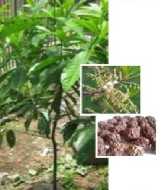
Discussion and feedback